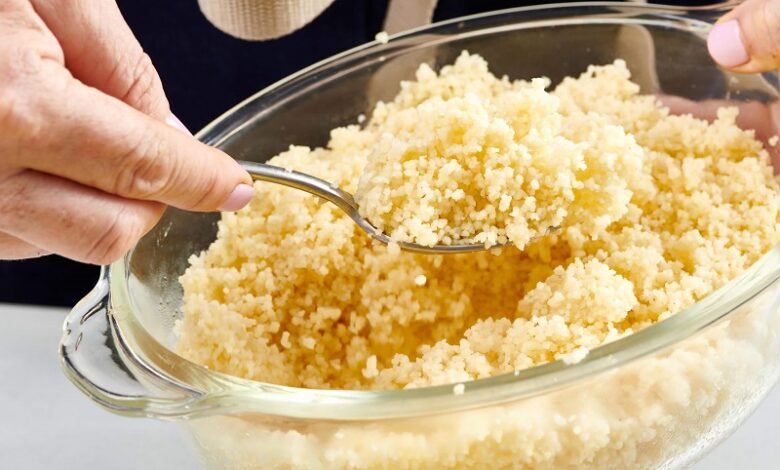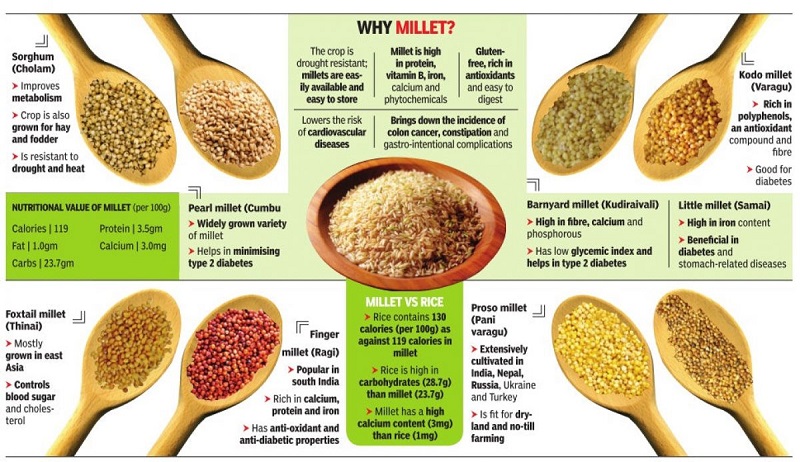Why Should Millet Take The Place Of Wheat And Rice As Your Plate’s Main Ingredients?

The United Nations has designated 2023 as the International Year of Millets. There is a wealth of news and information on millets in the media. The subject of whether millets are healthy for diabetics is one that comes up frequently these days.
What are millets?
Warm-weather grains called millets have been produced and eaten in the Indian subcontinent for more than 5,000 years. Millets, which are small, hardy grains with low water requirements and are members of the grass family, are quite resistant to drought and other adverse weather conditions. Fertilizers are not necessary for them. They can grow from seeds to harvest-ready crops in just over three months. Millets were reduced to being coarse or rural grains as wheat and rice took over India’s principal crops. However, their quick growth and lengthy storage survival (> 2 years) make them a fantastic choice for India.
Millets are fiber-rich, nutrient-rich grains that support the microflora in our gut by acting as a probiotic. Millet’s fiber moisturizes our gut and aids in preventing constipation. These days, cutting off gluten has practically become fashionable due to its extreme popularity. Millets are a great alternative to wheat if you wish to avoid gluten or have Celiac Disease because they are gluten-free. Generally speaking, they include 7–12% protein, 2–5% fat, 65–75% carbs, and 10–12% fiber.

India produces three types of millet: jowar (sorghum), bajra (pearl millet), and ragi (finger millet). Other small millets, such as foxtail, tiny, kodo, proso, and barnyard millet, are grown in particular areas of India.
The primary millet species differ in a few key ways. Jowar and bajra have a protein level of 10–11 gm/100 gm, which is comparable to whole wheat but greater than rice. About 7 gm of protein per 100 gm is found in ragi. Major millets have a fiber level that is close to whole wheat (approximately 11 g/100 g), but substantially greater than refined wheat flour or rice (around 3 g/100 g). However, one must be cautious when choosing processed millets from the store because they may have lesser fiber and nutritional values than natural or less processed millets. Iron is present in all three of the major millets, but bajra stands out in this regard. Ragi has a high calcium content and is the main non-dairy source of this mineral in Indian diets, making it especially beneficial for people with bone conditions like osteoporosis. If you want to consume more calcium without taking supplements or if you have a milk allergy or lactose intolerance, adding ragi to your diet is a terrific option. All three of the major millet contain B vitamins that are fat soluble. B3 is very abundant in Bajra (niacin).
What about millet and diabetes?
Millets may help reduce Type 2 diabetes risk and the HbA1c level in those with diabetes, according to a 2021 meta-analysis. This is due to the fact that certain grains have a lower glycemic index, also known as GI, which is a measure of how rapidly a diet boosts blood sugar levels. Millets’ high fiber content is primarily responsible for their lower GI. They are slowly digested and result in satiety sooner than refined grains. Millets minimize post-meal blood sugar rises even when added to meals. Diabetes patients who regularly ate millet experienced 12- to 15% reductions in fasting and post-meal blood glucose levels. In pre-diabetic people who drank millet often, the HbA1c level decreased (from 6.65 to 5.67%). In comparison to milled rice and refined wheat, minimally processed millets were 30% more successful at reducing the GI of a meal. Additionally, millet can limit cholesterol absorption, lowering the risk of heart disease. Millets are a wonderful alternative to white rice or refined wheat if you have diabetes or want to lower your risk of developing it.
In diabetes, all major millets are helpful. Jowar includes slowly soluble starch (SDS), which slows down the absorption of carbohydrates. In addition to fiber, antioxidant characteristics include vitamin E, phenolic chemicals, and tannins. Human studies have demonstrated that jowar-based diets lower diabetes patients’ post-meal blood glucose spikes. If refined flour is used instead of the coarse kind, this benefit is diminished. Bajra, which contains vitamin B3, may also lower triglycerides in addition to the general benefits of millet (niacin). Similar to jowar, ragi includes a slowly digested starch that slows down the absorption of carbohydrates. Additionally, the polyphenols in ragi suppress the enzyme aldose reductase, which may lessen the difficulties associated with diabetes.
Three major millets lack several nutritional qualities that minor millets do. For instance, foxtail and proso millet are especially rich in copper and niacin and have the highest protein level (>12g/100 g).
How may millet be incorporated into our everyday diet?
For preparations like porridge and upma, whole grain millets work nicely. They can be used to make khichdi as well. Chapatis can be made with millet flour, and idli or dosa can be made with the batter. But keep in mind that flour loses nutrients when it is treated or refined more. Utilizing combinations or rotating your millet use is an excellent strategy. This will guarantee that we benefit as much as possible.
Millets have the ability to lower blood sugar levels, lower the chance of developing diabetes, and make diabetes simpler to manage when consumed in moderation. Additionally, they aid in lowering cholesterol, lowering the risk of heart disease, and enhancing gut health. Although switching one’s go-to cereal is never simple, millets are worth a try right now.
News Mania Desk






